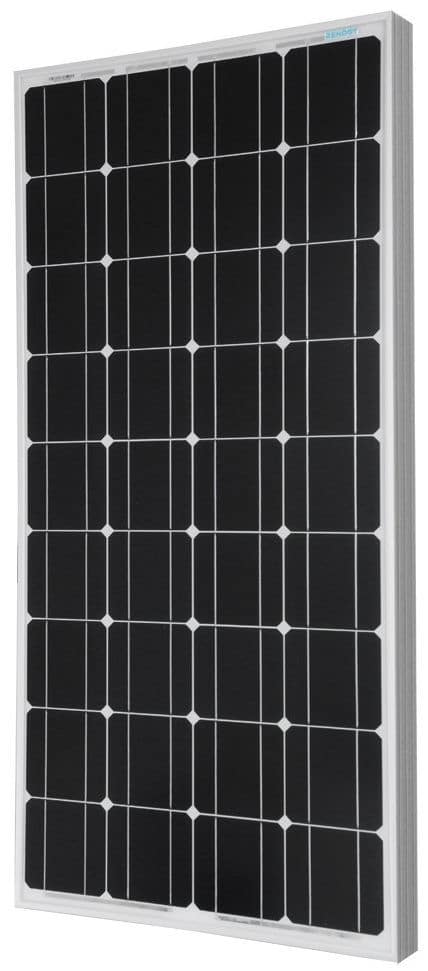
Connecting Solar Panels Together
How to Connect Solar Panels Together
![]() Connecting solar panels together is a simple and effective way of increasing your solar power capabilities. Going green is a great idea, and as the sun is our ultimate power source, it makes sense to utilize this energy to power our homes. As solar power becomes more accessible, more and more homeowners are buying photovoltaic solar panels.
Connecting solar panels together is a simple and effective way of increasing your solar power capabilities. Going green is a great idea, and as the sun is our ultimate power source, it makes sense to utilize this energy to power our homes. As solar power becomes more accessible, more and more homeowners are buying photovoltaic solar panels.
However, these photovoltaic solar panels can be very costly so buying them over time helps to spread the cost. But the problem then becomes how do we connect these extra solar panels together to increase the voltage and power output of what’s already there.
The trick here when connecting solar panels together is to choose a connection method that is going to give you the most energy efficient configuration for your particular requirements.
Connecting solar panels together can seem like a daunting task when you first start to look at how it should be done, but connecting multiple solar panels together is not that hard with a little thought. Wiring solar panels together in either parallel or series combinations to make larger arrays is an often overlooked, yet completely essential part of any well designed solar power system.
There are three basic but very different ways of connecting solar panels together and each connection method is designed for a specific purpose. For example, to produce more output voltage or to produce more current.
Solar photovoltaic panels can be electrically connected together in series to increase the voltage output, or they can be connected together in parallel to increase the output amperage. Solar pv panels can also be wired together in both series and parallel combinations to increase both the output voltage and current to produce a higher wattage array.
Whether you are connecting two or more solar panels, as long as you understand the basic principles of how connecting multiple solar panels together increases power and how each of these wiring methods works, you can easily decide on how to wire your own panels together. After all connecting solar panels together correctly can greatly improve the efficiency of your solar system.
Connecting Solar Panels Together in Series
The first method we will look at for connecting solar panels together is what’s known as “Series Wiring“. The electrical connection of solar panels in series increases the total system output voltage. Series connected solar panels are generally used when you have a grid connected inverter or charge controller that requires 24 volts or more. To series wire the panels together you connect the positive terminal to the negative terminal of each panel until you are left with a single positive and negative connection.
Solar panels in series add up or sum the voltages produced by each individual panel, giving the total output voltage of the array as shown.
Solar Panels in Series of Same Characteristics
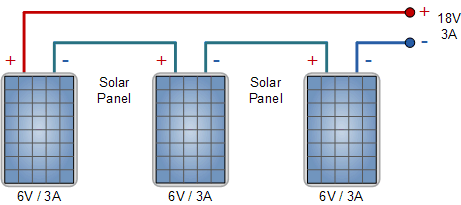
In this method ALL the solar panels are of the same type and power rating. The total voltage output becomes the sum of the voltage output of each panel. Using the same three 6 volt, 3.0 amp panels from above, we can see that when these pv panels are connected together in series, the array will produce an output voltage of 18 Volts (6 + 6 + 6) at 3.0 Amperes, giving 54 Watts (volts x amps) at full sun.
Now lets look at connecting solar panels in series with different nominal voltages but with identical current ratings.
Solar Panels in Series of Different Voltages
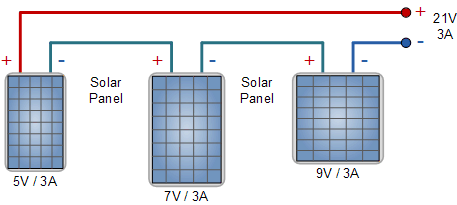
In this method all the solar panels are of different types and power rating but have a common current rating. When they are connected together in series, the array produces 21 volts at 3.0 amps, or 63 watts. Again the output amperage will remain the same as before at 3.0 amps but the voltage output jumps to 21 volts (5 + 7 + 9) .
Finally, lets look at connecting solar panels in series with completely different nominal voltages and different current ratings.
Solar Panels in Series of Different Currents
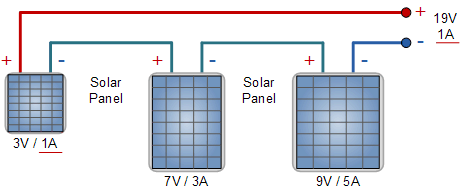
In this method all the solar panels are of different types and power rating. The individual panel voltages will add together as before, but this time the amperage will be limited to the value of the lowest panel in the series string, in this case 1 Ampere. Then the array will produce 19 Volts (3 + 7 + 9) at 1.0 Ampere only, or only 19 watts out of a possible 69 watts available reducing the arrays efficiency.
We can see that the solar panel rated at 9 volts, 5 amps, will only use one fifth or 20% of its maximum current potential reducing its efficiency and wasting money on the purchase of this solar panel. Connecting solar panels in series with different current ratings should only be used provisionally, as the solar panel with the lowest rated current determines the current output of the whole array.
Connecting Solar Panels Together in Parallel
The next method we will look at of connecting solar panels together is what’s known as “Parallel Wiring“. Connecting solar panels together in parallel is used to boost the total system current and is the reverse of the series connection. For parallel connected solar panels you connect all the positive terminals together (positive to positive) and all of the negative terminals together (negative to negative) until you are left with a single positive and negative connection to attach to your regulator and batteries.
When you connect solar panels together in parallel, the total voltage output remains the same as it would for a single panel, but the output current becomes the sum of the output of each panel as shown.
Solar Panels in Parallel of Same Characteristics
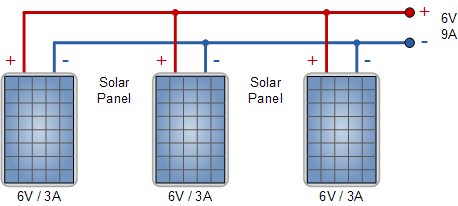
In this method ALL the solar panels are of the same type and power rating. Using the same three 6 Volt, 3.0 Amp panels as above, the total output of the panels, when connected together in parallel, the output voltage still remains at the same value of 6 volts, but the total amperage has now increased to 9.0 Amperes (3 + 3 + 3), producing 54 watts at full sun.
But what if our newly acquired solar panels are non-identical, how will this affect the other panels. We have seen that the currents add together, so no real problem there, just as long as the panel voltages are the same and the output voltage remains constant. Lets look at connecting solar panels in parallel with different nominal voltages and different current ratings.
Solar Panels in Parallel with Different Voltages and Currents
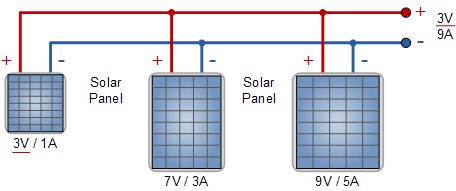
Here the parallel currents add up as before but the voltage adjusts to the lowest value, in this case 3 volts or some voltage value very close to 3 volts. Solar panels must have the same output voltage to be useful in parallel. If one panel has a higher voltage it will supply the load current to the degree that its output voltage drops to that of the lower voltage panel.
We can see that the solar panel rated at 9 volts, 5 amps, will only operate at a maximum voltage of 3 volts as its operation is being influenced by the smaller panel, reducing its efficiency and wasting money on the purchase of this higher power solar panel. Connecting solar panels in parallel with different voltage ratings is not recommended as the solar panel with the lowest rated voltage determines the voltage output of the whole array.
Then when connecting solar panels together in parallel it is important that they ALL have the same nominal voltage value, but it is not necessary that they have the same ampere value.
Connecting Solar Panels Together Summary
Connecting solar panels together to form bigger arrays is not all that complicated. How many series or parallel strings of panels you make up per array depends on what amount of voltage and current you are aiming for. If you are designing a 12 volt battery charging system than parallel wiring is perfect. If you are looking at a higher voltage grid connected system, than you’re probably going to want to go with a series or series-parallel combination depending on the number of solar panels you have.
But for a simple reference in regards to how to connect solar panels together in either parallel or series wiring configurations, just remember that parallel wiring = more amperes, and series wiring = more voltage, and with the right type and combination of solar panels you can power just about any electrical device you may have in your home.
For more information about Connecting Solar Panels Together in either series or parallel combinations, or to obtain more information about the different types of solar panels available, or to explore the advantages and disadvantages of using solar power in your home, then Click Here to order your copy from Amazon today and learn more about designing, wiring and installing off-grid photovoltaic solar electric systems in your home.











Hello sir I have a 12v 220a battery and a 1kva inverter and 2, 450 watt panels how do I connect the panels my charge controller is 80a 12v,24v,48v auto
Then again I have twelve 300 watts panels 5kva hybrid inverter and four 12v 200a battery I need to make it 48v system please how do i do the panel configurations
1. 450W pv panels are generally rated as 24V panels, then the two in parallel.
2. Depending on the maximum open-circuit DC input characteristics of your controller/inverter, for 48V operation, 2 in a series strings and 6 parallel branches (2S6P), or 3 in a series string and 4 parallel branches (3S4P)
hello i have 9x 235w panels giving 29.5v at 7.97 amps to a (2)100amp mppt controller on 24volt to 4 x 130 ah wet batteries wired series/parallel to a 2500w(5000wsurge) 24v invertor to run two caravans on mains connection which would be the best way to wire the panels ? 2 x 4 panels with one spare? in parallel or all nine in parallel and increase battery storage upto 8 x 130 ah wet batteries to two inverters? thanks for any advice you can give me
The configuration of your photovoltaic panels will depend on the maximum PV array paramenters of your controller with regards to system voltage and open circuit voltage (Voc), since a 235W, 60 cell panel can be as high as 40 volts. Then if you plan on connecting 4 in series, your Voc could reach 160 volts. As you have stated, you have 9 x 235W panels, then the maximum wattage your array can generated at FULL SUN is 2115W, no matter how you configure them. Again, higher voltage is better than higher current as it allows for smaller diameter cabling.
Hi Sir, I have 315w 24v 9 panels and 2kw 24v hybrid solar invertor with batteries; how i will connect these panels , plz share a diagram, i want to made a rooftop installation . Thanks in advance
Hi good evening please I have 8 450 WATT of solar panels with 30 volt from each panels, now I connect 4, 4 in series which now give me 120 volt and 30 AMP and using an MPPT CHARGING CONTROLLER 120, AMP with Maximum PV input 195 volt, wire with 16 MM cable but I now discover that the wire from the charging controller to the head of the batteries is hot, please what cam be the caused of this?
16mm2 cable should be good for 30 amperes. Is your cable hot along the entire length of the cable, or just hot at one end near the battery joint. If the ends of the wire are hotter, that may be a sign of a bad connection at that end.
Heat is the result of I2R power loss along the whole length of a cable, and some “warm” wires in a DC solar setup is normal. Use a multi-meter to check the voltage drop between both ends of the cable. 3% difference or less is ok. Then check all connections and monitor over time.
If i use 4 panels of 550 watt with 3.5 kw inverter and 2 batteries of 12v then what appliances can i run with this setup?
Any you want upto the maximum rating of your inverter
Hi, I want to use this opportunity to say thank you for this information I really learn from it and I we like to know more sir
thanks for your advice , the best but sometimes confusing , so here I go … I’m wishing to connect 3 solar panels of 300 watts each in parallel in a 12 volt system where the Maximum Power Current IMP:17.24A